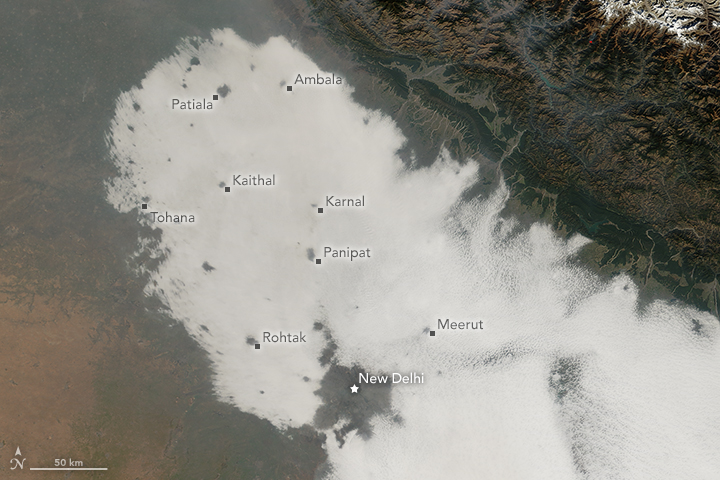


It’s not unusual for low clouds and haze to blanket northern India, just south of the Himalayas. You can see evidence of this in a gallery of satellite images we have accumulated over the years. But on December 7, 2016, the Moderate Resolution Imaging Spectroradiometer (MODIS) on NASA’s Terra satellite captured images of curious structures among the familiar cloud cover.
The first image shows a wide view of the clouds and smog trapped against the Himalayas. For the most part, the clouds appear white, although some areas are obscured with a dull gray haze. The second image shows a detailed view of clouds that appear uniquely mottled. The locations of the “holes” happen to coincide with cities, including India’s capital, New Delhi.
The cause of these features is a mystery. “I would definitely say there is a connection with the cities,” said Steve Lang, a research meteorologist at NASA’s Goddard Space Flight Center. “But without being there, we can only speculate that it could be due to either additional aerosols or urban heat islands, or both, having an effect on the clouds.”
The holes appear similar to hole-punch clouds, which occur when super-cooled liquid clouds are disturbed, usually by the particles in airplane exhaust. The exhaust triggers a cascade of freezing: ice particles bump into liquid drops, and then larger ice particles literally fall out of the sky and leave behind a hole.
But Lang and colleagues checked other lines of evidence—different MODIS channels, local reports, and soundings—and think that these are water clouds (essentially fog). It could be that the fog was burning off faster over the cities, which tend to be warmer than their surroundings.
“Most likely, the urban heat island is added to the effects of the Sun as it burns off the fog,” Lang said. “It could also be that the fog was thinner over the cities to begin with due to the heat island effect.”
Andrew Ackerman, a scientist at NASA’s Goddard Institute for Space Studies, agrees that aerosols could have played a role in forming the holes. He previously published research showing that clouds clear more quickly in the presence of dark, solar-absorbing haze over the Indian Ocean. Ackerman noted: “The same physics would apply to more localized sources of solar-absorbing aerosols.”
NASA Earth Observatory images by Jeff Schmaltz, using MODIS data from LANCE/EOSDIS Rapid Response. Caption by Kathryn Hansen, with image interpretation by Steve Lang, Toshihisa Matsui, and Stephen Nicholls.